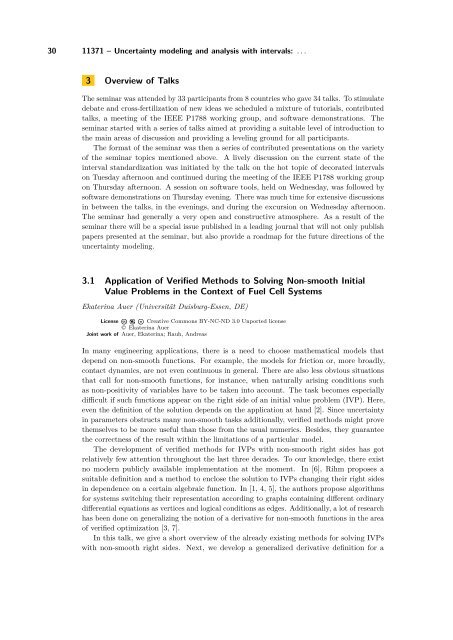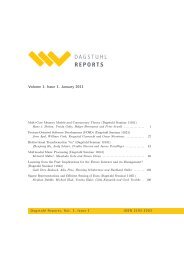Uncertainty modeling and analysis with intervals - DROPS - Schloss ...
Uncertainty modeling and analysis with intervals - DROPS - Schloss ...
Uncertainty modeling and analysis with intervals - DROPS - Schloss ...
Create successful ePaper yourself
Turn your PDF publications into a flip-book with our unique Google optimized e-Paper software.
30 11371 – <strong>Uncertainty</strong> <strong>modeling</strong> <strong>and</strong> <strong>analysis</strong> <strong>with</strong> <strong>intervals</strong>: . . .<br />
3 Overview of Talks<br />
The seminar was attended by 33 participants from 8 countries who gave 34 talks. To stimulate<br />
debate <strong>and</strong> cross-fertilization of new ideas we scheduled a mixture of tutorials, contributed<br />
talks, a meeting of the IEEE P1788 working group, <strong>and</strong> software demonstrations. The<br />
seminar started <strong>with</strong> a series of talks aimed at providing a suitable level of introduction to<br />
the main areas of discussion <strong>and</strong> providing a leveling ground for all participants.<br />
The format of the seminar was then a series of contributed presentations on the variety<br />
of the seminar topics mentioned above. A lively discussion on the current state of the<br />
interval st<strong>and</strong>ardization was initiated by the talk on the hot topic of decorated <strong>intervals</strong><br />
on Tuesday afternoon <strong>and</strong> continued during the meeting of the IEEE P1788 working group<br />
on Thursday afternoon. A session on software tools, held on Wednesday, was followed by<br />
software demonstrations on Thursday evening. There was much time for extensive discussions<br />
in between the talks, in the evenings, <strong>and</strong> during the excursion on Wednesday afternoon.<br />
The seminar had generally a very open <strong>and</strong> constructive atmosphere. As a result of the<br />
seminar there will be a special issue published in a leading journal that will not only publish<br />
papers presented at the seminar, but also provide a roadmap for the future directions of the<br />
uncertainty <strong>modeling</strong>.<br />
3.1 Application of Verified Methods to Solving Non-smooth Initial<br />
Value Problems in the Context of Fuel Cell Systems<br />
Ekaterina Auer (Universität Duisburg-Essen, DE)<br />
License Creative Commons BY-NC-ND 3.0 Unported license<br />
© Ekaterina Auer<br />
Joint work of Auer, Ekaterina; Rauh, Andreas<br />
In many engineering applications, there is a need to choose mathematical models that<br />
depend on non-smooth functions. For example, the models for friction or, more broadly,<br />
contact dynamics, are not even continuous in general. There are also less obvious situations<br />
that call for non-smooth functions, for instance, when naturally arising conditions such<br />
as non-positivity of variables have to be taken into account. The task becomes especially<br />
difficult if such functions appear on the right side of an initial value problem (IVP). Here,<br />
even the definition of the solution depends on the application at h<strong>and</strong> [2]. Since uncertainty<br />
in parameters obstructs many non-smooth tasks additionally, verified methods might prove<br />
themselves to be more useful than those from the usual numerics. Besides, they guarantee<br />
the correctness of the result <strong>with</strong>in the limitations of a particular model.<br />
The development of verified methods for IVPs <strong>with</strong> non-smooth right sides has got<br />
relatively few attention throughout the last three decades. To our knowledge, there exist<br />
no modern publicly available implementation at the moment. In [6], Rihm proposes a<br />
suitable definition <strong>and</strong> a method to enclose the solution to IVPs changing their right sides<br />
in dependence on a certain algebraic function. In [1, 4, 5], the authors propose algorithms<br />
for systems switching their representation according to graphs containing different ordinary<br />
differential equations as vertices <strong>and</strong> logical conditions as edges. Additionally, a lot of research<br />
has been done on generalizing the notion of a derivative for non-smooth functions in the area<br />
of verified optimization [3, 7].<br />
In this talk, we give a short overview of the already existing methods for solving IVPs<br />
<strong>with</strong> non-smooth right sides. Next, we develop a generalized derivative definition for a













